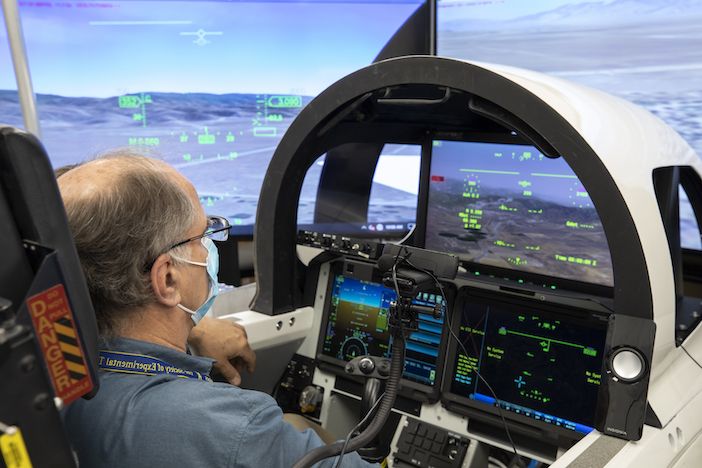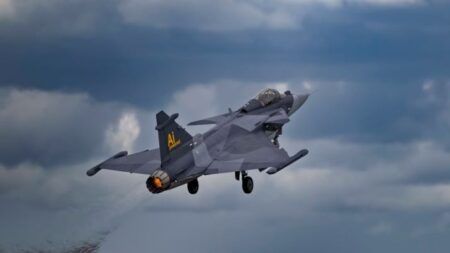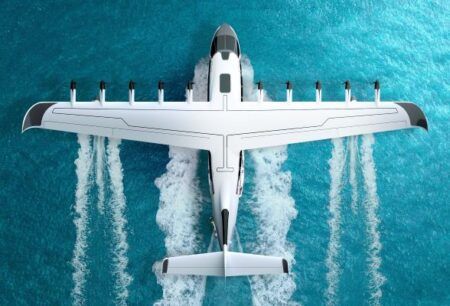The eXternal Vision System (XVS) for its X-59 Quiet SuperSonic Technology is ready to be integrated into the aircraft after researchers at NASA’s Langley Research Center in Virginia, USA successfully completed its testing program.
The eXternal Vision System (XVS) for the X-59 demonstrator is testing technologies that enable aircraft to travel over land at supersonic speeds and create a sonic “thump” instead of a boom. The goal of the program is to provide data for the US Government and international regulators to change the laws around supersonic commercial aviation.
The XVS is a forward-facing multi-camera and display system that shows the airspace in front of the X-59 . A 4K-monitor serves as the central “window” allowing the pilot to safely see traffic in their flight path while also providing graphical flight data in an augmented reality for approaches, landings, and takeoffs.
The vision system enables the sonic-boom mitigating aerodynamic design of the X-59, an elongated nose that requires the cockpit to sit low in the main body of the aircraft, leaving no place for a forward-facing window and creating a visual blockage for the pilot. It also replaces the need for the droop nose found in the only previous supersonic commercial passenger aircraft ever developed, Concorde.
The tests conducted on the XVS at Langley have included flight testing and structural stability tests. The system has been sent to Lockheed Martin in California to be integrated into X-59.
“Our goal is to create an electronic means of vision for the X-59 pilot that provides performance and safety levels equivalent to, or better, than forward-facing windows,” said Randy Bailey, XVS subsystem lead.
The in-flight testing of the XVS technology took place on NASA’s Beechcraft King Air UC-12B. The hardware was installed into the cabin of the King Air and wired to an exterior camera on the nose. Live flight test scenarios were flown to collect data on the pilot’s ability to see and maneuver around another aircraft in the airspace.
Researchers then performed a side-by-side comparative evaluation by measuring the pilot’s ability to detect the additional NASA aircraft flying nearby.
During the tests one pilot was seated in the cockpit of the King Air and could see through the forward windows, while the other pilot was seated in the King Air’s cabin using only the XVS for external awareness. The tests included multiple scenarios such as an offset nose-to-nose trajectory, which is like having a car in your blind spot while driving. Other scenarios tested traffic crossing at the same altitude, like a dangerous city intersection, and aircraft approaching from below.
Within each scenario the two pilots would push a button the moment they detected the other aircraft, and the time it took each pilot to recognize the target aircraft was recorded for study.
“I’ve continued to get more and more comfortable with the XVS through flight tests and our X-59 flight simulators,” said Nils Larson, NASA X-59 test pilot.
After the successful in-flight tests of the XVS, researchers then tested the structural integrity of the system through a series of vibration tests.
The XVS is comprised of three major components: the XVS pallet, the camera system, and the 4K monitor. The XVS pallet is what contains the computer processors, network equipment, video distribution, and power distribution components – the brain of the system.
Researchers carefully tested the pallet at vibration levels expected in the flight environment to ensure the equipment will function nominally when installed on the X-59.
Lockheed Martin, who’s building the X-59 at their Skunk Works facility in Palmdale, California, developed an Environmental Requirements and Test Document that defines the expected environment for the X-59.
“All equipment that will fly on the X-59 has to meet the requirements in the document from either manufacturer certification, test, or analysis,” said Kemper Kibler, NASA lead hardware engineer for the XVS.
By conducting these tests, researchers were able to identify and correct any design or workmanship issues before the equipment is installed on the aircraft, preventing a scenario where a component could fail in such a way that causes damage to the aircraft or injures the flight crew.
The Low-Boom Flight Demonstration mission and the XVS team have performed multiple tests at different NASA and vendor facilities including temperature, altitude, vibration, explosive decompression, and gaseous nitrogen environments.
Source: NASA
Related Stories
VIDEO: Watch the X-59 QueSST supersonic aircraft take shape at Lockheed Martin’s Skunk Works
Collins supplies avionics for windowless X-59 supersonic aircraft





